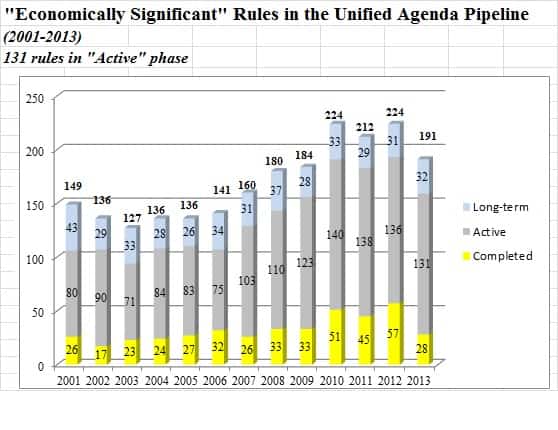Red Tapeworm 2014: Big Dollar Federal Regulations in the Pipeline Highest under Obama

This is Part 21 of a series taking a walk through some sections of Ten Thousand Commandments: An Annual Snapshot of the Federal Regulatory State (2014 Edition)
There were 3,305 rules in the Unified Agenda of Federal Regulations at year-end 2013. It’s the place where federal regulatory agencies outline their upcoming priorities. Agencies regularly finalize over 3,500 rules each year.
A subset of these rules is classified as “economically significant,” meaning (usually) that agencies anticipate yearly economic impacts of at least $100 million. Those impacts generally amount to increased costs, although occasionally an economically significant rule is intended to reduce burdens on the public.
At year-end 2013, economically significant rules from 26 separate departments and agencies appeared at the active (prerule, proposed rule, and final rule), completed, and long-term stages (See Table 6 in Ten Thousand Commandments for the breakdown by agency).
We’ve noted before that the overall number of rules in the Unified Agenda is down, and we discussed why, including reasons that involve political delays.
But when it comes to the costly, economically significant rules at the Completed and Active stage, the chart nearby shows that the current administration is in a class by itself when one looks at the year-end flow. The overall number of “economically significant” rules issued during the current administration is higher than at any time earlier in the decade. President George W. Bush started the upward trend; President Barack Obama continued it.

As shown, 2013’s 191 rules do represent a substantial drop from the prior three years but nonetheless they remain well above anything witnessed before 2010. President Obama clearly tolerates a substantially higher flow of these economically significant rules in the pipeline—at least given these year-end snapshots—ccompared with the early part of the decade before his terms.
Since the recent online database editions of the Agenda break economically significant rules into completed, active, and long-term, it is now easier to compile a more useful tally of economically significant rules completed annually over the years by their stage of completion.
Among the 191 rules, the body of “active” economically significant rules has not changed substantially during Obama’s five years (they numbered 131 in 2013, and 123 in 2009), but they are clearly well above levels earlier in the decade.
The smaller level of Completed rules over the past year (from 57 in 2012 to 28 in 2013, a 51 percent drop) conforms with the now-apparent effort to dial back on regulations during 2012, which was reflected in fewer completed rules being issued in the Agenda overall.
This is very significant. Yet the lower number of completed rules in the Fall Agenda does not necessarily mean lower costs, as is reflected in costs presented by OMB in the 2013 Draft Report to Congress on the Benefits and Costs of Federal Regulatory and Deregulatory Actions. Costs have risen in OMB’s reports despite the lower number of rules reported in the pipeline. There’s a reporting disconnect.
Next time we’ll look a little closer at completed rules.
- Part 1: Guess Which Is the Largest Government on Earth?
- Part 2: Tardy Bureaucrats Gone Wild
- Part 3: Reckoning the Dollar Cost of Federal Regulation
- Part 4: Regulations Catching Up to Government Spending?
- Part 5: Regulations Cost More than Federal Income Taxes
- Part 6: The Federal Government “Eats” 31 Percent Of The U.S. Economy
- Part 7: U.S. Regulation Compared to the World’s Largest Economies
- Part 8: The High Cost of Overcriminalization
- Part 9: Thousands of Federal Register Pages
- Part 10: A Record Number of Federal Register Final Rule Pages
- Part 11: Federal Register Pages Per Decade
- Part 12: Number of Proposed and Final Rules In the Federal Register
- Part 13: Cumulative Final Rules in the Federal Register
- Part 14: The Expanding Code of Federal Regulations
- Part 15: A Fourth of July Reflection on Presidential Executive Orders and Loss of Liberty
- Part 16: Over 24,000 Pen and Phone “Public Notices” Annually
- Part 17: When Regulations Get Delayed
- Part 18: Federal Regulatory Disclosure Becomes More Confused
- Part 19: Federal Regulatory Agenda Consistently Tops 3,000 Rules
- Part 20: Here Are the Federal Agencies that Issue the Most Regulations